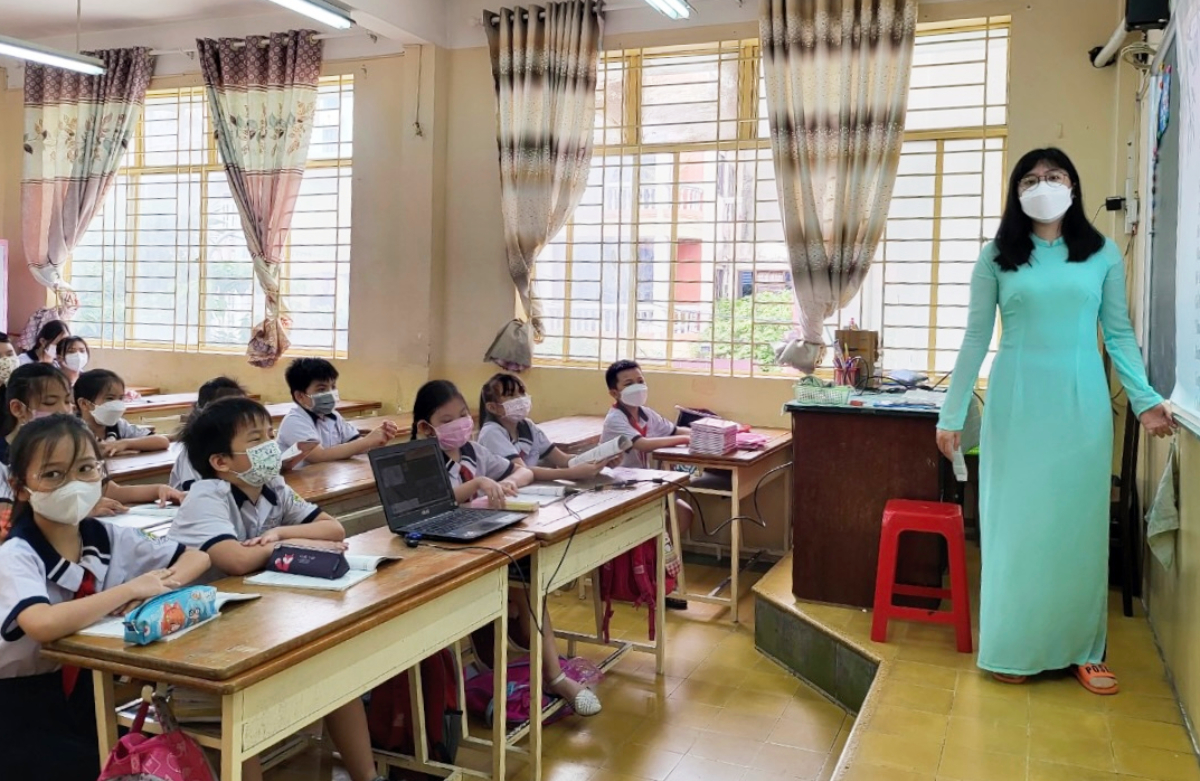Nguyen Minh Hanh, a high school chemistry teacher in Hanoi’s Hoang Mai District, was tired and found it difficult to breathe 10 minutes into her lecture.
She had to speak softly and slowly in order to be able to breathe. After another 20 minutes she apologized to her students and gave them an exercise to do while she sat down to rest.
She says: “I could not carry on with the lecture. Fortunately, I only had one lesson scheduled for that day”.
Hanh contracted Covid earlier this month after her son developed a runny nose and later tested positive. She informed the school she could continue teaching from home because she was feeling fine.
But soon her condition worsened and, once she started teaching, quickly became exhausted.
She was supposed to teach seven periods the next day, but asked the school for a break.
After many contracted Covid, the school is running low on teachers. Thus, those with mild symptoms continue to teach from home. There are nine chemistry teachers at Hanh’s high school, but nearly half have gotten Covid.
Hanh says teachers are feeling overwhelmed despite working from home since they have to come up with two test versions for students attending classes online and in person.
The number of students contracting Covid at school is increasing by the day, leaving fewer and fewer of them in the classroom.
Hoa, 37, a primary school teacher in Hanoi’s Dong Anh district, says she has been struggling to teach both face-to-face and online since mid-February, and wishes she can “clone” herself to handle both.
She teaches in-person to around 25 out of a total of more than 40 students. She then has to organize online lessons for infected students and those who came into contact with them – categorized as F0 and F1 — but the school has poor Internet connection and lacks equipment.
So she puts students into small groups and tutors them from afternoon until late evening, resulting in a bigger workload.
“I also had to redesign the lesson plan to keep up with both online and offline teaching methods. This takes time and is far more difficult than teaching entirely online”.
Her two children contracted Covid and so she asked to teach her entire class online to mitigate infection risk.
Her school requires any class with more than half the students F0 or F1 to go online.
They accounted for nearly half in her class, and so the school accepted Hoa’s request.
But after teaching for a few days, she noticed she was tiring quickly and her throat was sore. She tested positive for Covid and reported to the principal, but was encouraged to continue since there were not enough teachers.
She explains: “I sympathized with the principal’s suggestion. Even though I was exhausted, I believed I could still teach online”.
But she was exhausted after a few days and her condition worsened, and she just wanted to lie down and not even eat or drink after an online class.
On Feb. 27 the Hanoi administration approved a proposal by the Department of Education and Training to allow students in grades one to six in 18 suburban districts to switch back to online classes.
Since schools now only have to teach online and some of the other teachers have recovered, Hoa’s school has arranged for a substitute for her.
She says: “I still feel very tired. Fortunately, the school found someone to substitute until I recover”.
Meanwhile, the number of daily cases in the city has kept climbing, reaching 32,650 on Tuesday.
A study by the department at the end of February found that children accounted for 10 percent of the total number of infections, or 17,300.
In Ho Chi Minh City, preschool children and high school students resumed in-person classes after the Lunar New Year holidays.
But nearly 10,000 have been infected since then and the number is growing, causing teaching methods to be changed on a regular basis.
There has not been a situation yet where only a handful of students are in classrooms as has happened in Hanoi, but many schools are seeing an online – offline ratio of 50:50.
 |
|
Hoang Thuy Lan Anh, homeroom teacher for class 4/7 at the Phan Dinh Phung Primary School in HCMC’s District 3, teaches 21 students in the classroom and 28 others at home. Photo by VnExpres/Manh Tung |
Hoang Thuy Lan Anh’s class 4/7 at the Phan Dinh Phung Primary School in District 3 was missing 28 students on March 2 after seven contracted Covid.
She taught 21 children with a computer in front of her and Zoom turned on for the benefit of those studying at home.
Face-to-face classes are sometimes stopped briefly to allow teachers to guide students at home and answer their questions.
Lan Anh says: “It is extremely difficult to teach a combination of these two because it is impossible to control all of their learning. Online learning is ineffective, and many children lack self-discipline”.
She also has many other tasks in addition to teaching twice a day, including answering questions from students and parents.
Besides, teachers are required to contact students’ families on a regular basis to understand the situation and record the health status of the children and report to the school.
Lan Anh says: “Every day since I returned to school I have been receiving two or three calls from parents to discuss their children’s academic progress.
“Many parents are also frustrated because their children had to stay home after a few days of studying. I comfort them saying parents and students should work together to overcome these obstacles”.
After the fourth wave of Covid began in April last year many students spent more than nine months studying online.
The Ministry of Education and Training advocated reopening all schools after the Lunar New Year, saying online learning is ineffective, reduces social interaction and could have psychological and health consequences for students.
But as community infections increased after the holidays, so did the number of infections at schools.
According to ministry statistics, the entire education sector recorded more than 162,000 cases of Covid-19 infection from April 27 last year to February 20 this year, with officials and teachers accounting for more than 27,600 of the total of approximately one million teachers.
The education ministry remains committed to the concept of providing both online and offline lessons. However, due to the sharp increase in the number of infections across the country, this model is requiring a significant amount of effort from teachers, students and parents.
- Reduce Hair Loss with PURA D’OR Gold Label Shampoo
- Castor Oil Has Made a “Huge” Difference With Hair and Brow Growth
- Excessive hair loss in men: Signs of illness that cannot be subjective
- Dịch Vụ SEO Website ở Los Angeles, CA: đưa trang web doanh nghiệp bạn lên top Google
- Nails Salon Sierra Madre
 VnExpress News The News Gateway of Vietnam
VnExpress News The News Gateway of Vietnam





